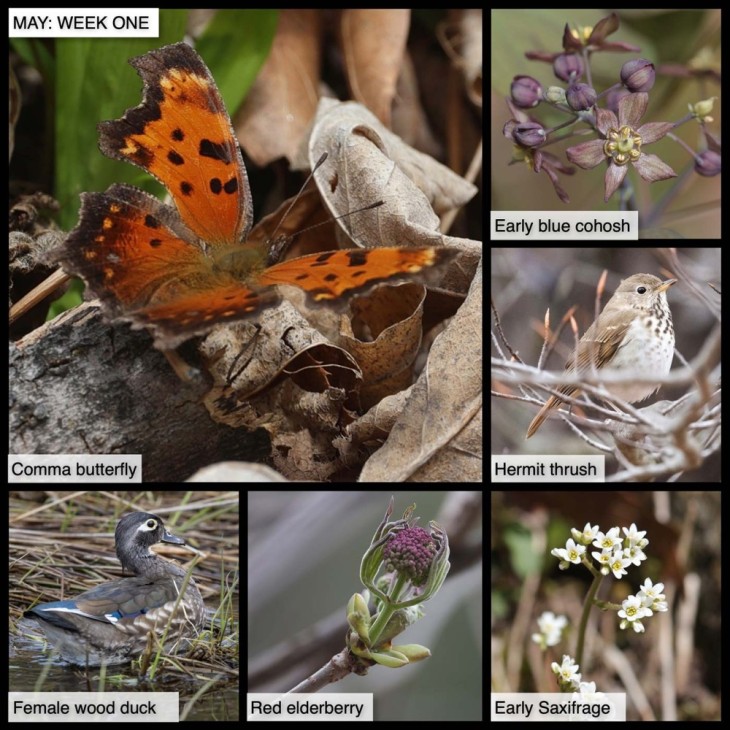This Week in the Woods, we’ve seen several pumpkin orange-colored anglewing (Polygonia) butterflies. After some expert input, we’re reasonably confident that the butterfly in the photograph is a gray comma, especially given its proximity to a patch of that species’ typical caterpillar food plant, gooseberry. Like mourning cloaks and their look-alike cousins eastern commas, gray commas overwinter as adults and can emerge as early as March on warm, sunny days. Here’s a species profile from the Vermont Center for Ecostudies.
Here are some other nature sights this week (clockwise):
Early blue cohosh is blooming. These plants prefer rich, rocky soils, and we found some growing in a patch of hepatica, trillium, and other spring ephemerals, as well as emerging maidenhair ferns. When first comes out of the ground, you may not immediately recognize it as a plant; it’s blackish-purple, and its furled leaves have a tentacle-like appearance. As it grows and blooms, its leaves start to slowly unfurl and green up. Here’s a profile of early blue cohosh from the Native Plant Trust. Note: there is also a closely related species, blue cohosh, that typically has more green-yellow colored young blooms.
Hermit thrushes are back and singing in the woods again. As Susan Shea notes in this Outside Story essay, the birds typically lay their pale blue eggs “in a natural depression atop a small mound – maybe in a patch of clubmoss on the forest floor, or at the top of a steep bank along a woods road.”
Tough and tiny early saxifrage has started blooming among the rocks. See this description of the plant from Mary Holland’s Naturally Curious blog, noting that its covering of small hairs may deter ants and thereby advantage other, more efficient pollinators. (Also on her blog, you can purchase a copy of her Naturally Curious month-to-month field guide – a highly recommended resource!)
Red elderberry’s purple blooms are opening. This beautiful wild shrub has significant wildlife value. As noted in this profile from the Wild Seed Project, it has highly nutritious pollen, its buds and bark provide winter food for snowshoe hare, deer, and other winter creatures, and its summer-ripening fruits feed “up to fifty species of passerine birds and six species of game birds” as well as many mammals. (Although, important note, they’re often toxic to humans).
Finally, a special note of appreciation for female wood ducks. The males – with their flashy, parrot-like breeding plumage – get a lot of attention, but the female birds are also very beautiful, presenting iridescent blue wing feathers and yellow eyeliner. This time of year, you can find mated pairs visiting vernal pools as well as larger water bodies. Like hooded mergansers, wood ducks nest in tree cavities, sometimes as high as 60 feet above the forest floor. Here’s a species profile from Audubon which notes that the wood duck’s closest cousin is the mandarin duck.
Our thanks to The Bailey Charitable Foundation and the Frank and Brinna Sands Foundation for helping to support this series.
In this difficult period, many of us find joy in observing local nature. This series, launched in April 2020, shares nature photographs taken in the past seven days, or in the same week in 2020, most within 15 miles of the Northern Woodlands office in Lyme, New Hampshire. We hope you enjoy using this grid as a prompt for your own explorations.
What are you seeing in the woods this week? Share your images with us on Facebook, or submit a special photo for possible inclusion in our monthly online Reader Photo Gallery.


